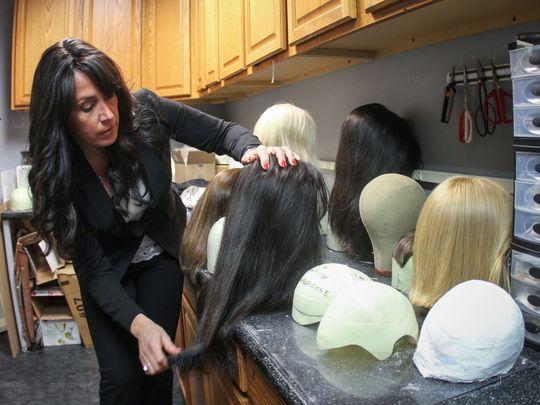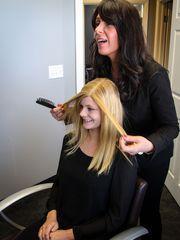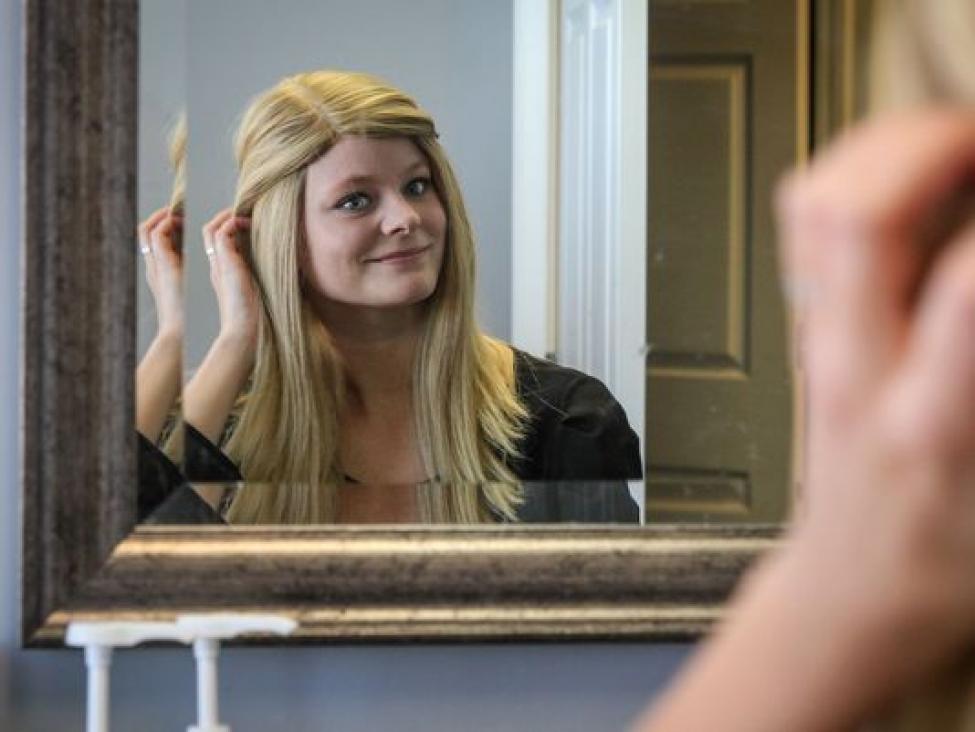Malin Mumford first noticed it on Valentine's Day of 2014, as she got ready for a date night with her husband.
Something wasn't quite right with the hair above her ear.
"It just looked different," the Ocean Grove resident recalled. "After a little while, I realized I was losing my hair. I had bald spots.
She was diagnosed with Alopecia Areata, a condition where the immune system mistakenly attacks hair follicles. It's not life-threatening, but it can be life-altering.
"It was a six-month roller-coaster," said the 24-year-old Mumford, who works as a nanny. "You become obsessed about hair. You wake up and look on your pillow and see how much hair you lost last night. I would see it on my clothes, on the floor, in my car. It would come out slowly — not big chunks of it."
According to the National Alopecia Areata Foundation, the disease affects 2 percent of the population on some level. For some, it's temporary and the hair grows back. For others, the baldness is permanent.
 (Photo: Tom Spader/staff photographer)
(Photo: Tom Spader/staff photographer)
"Everyone says it doesn't matter, but it does," said Danielle Marzella, owner of Transitions Hair Solutions in Wall. "People judge you on what you look like. If you don't have hair, people think you must be sick."
Grillo said alopecia patients account for "at least half" of her clientele.
"We take care of men as well as women, but it's acceptable for a man to shave his head," Grillo said. "For women, it's not as accepted. I don't know why."
Although her husband, Quincy, remained fully supportive, Mumford said she covered up her bald spots with a tight pony tail or a hat for a few months, before finally seeking help. Transitions Hair Solutions was her third stop.
"At the point when I went to see Danielle, I lost 70 percent of my hair, and I just didn't feel good about myself anymore," she said.
Finding the right wig
Grillo said her hair replacement solutions can range from "$300 for tying hairs in to $10,000, depending on what you're looking for." Depending on the diagnosis and device, Grillo said, some insurance companies will cover a percentage of the costs.
Mumford's situation required urgent action, so they found a quality wig for her to wear until a more custom solution could be executed. She opted for blonde, straight, relatively long hair, replicating her natural look.
 (Photo: Tom Spader/staff photographer)"Sixty percent of (wig-shoppers) just want to look like themselves," Grillo said. "They don't want to draw attention. Then there are women who'll say, 'I'm tired of blonde hair, give me some red.' I love when they do that and embrace the situation they're going through."
(Photo: Tom Spader/staff photographer)"Sixty percent of (wig-shoppers) just want to look like themselves," Grillo said. "They don't want to draw attention. Then there are women who'll say, 'I'm tired of blonde hair, give me some red.' I love when they do that and embrace the situation they're going through."
The wig, Mumford said, makes a huge difference.
"I took my husband and mother-in-law to try on the wig for the first time. It was very emotional for all of us," she said. "It's not a place you want to go to, or expect that you will ever have to go to, but when I put it on, I felt like myself again. It does a lot for your self-esteem."
Grillo, who hails from Toms River and has spent two decades in the hair salon business, said her job consists largely of listening. Once clients feel comfortable with her, she makes suggestions.
The biggest one?
"Get something good," Grillo said. "When someone says, 'You have a wig,' that's not a compliment."
A longer-term solution
Comfortable as she is with her wig, Mumford needed to take an extra step.
"I didn't want my hair to hold me back from being at the beach and going in the water this summer, or doing yoga and being upside down — the stuff I would normally do but can't do anymore," she said.
Added Grillo, "She's 24 years old; she wants to go do things and not worry this coming off."
So she got fitted for a CNC hair prosthesis system, which will be "permanently attached with a medical adhesive that comes off every 4 to 6 weeks," Grillo explained. "We'll see her once a month and clean her scalp, and the (hair) itself will take a bath."
Mumford has been fitted for one. They take three months to make, and she's due to receive hers in May.
Suffice it to say she's excited.
"I admire women who go out bald, but I'm not there yet, and I don't know if I will ever be," Mumford said. "You don't want to be that person who stops living because of something like this."
Here are Malin Mumford's dos and don'ts for women who are dealing with hair loss and seeking a solution.
1. Don't settle. I know how it is to be in a situation where you want a quick solution. I did too, but I decided to go to a few places before deciding and that's how I ended up at Danielle's. She was the one who truly helped me find a wig that made me feel like myself again.
2. Spend the money. I'm far from rich, but for me it's totally worth it to buy high-quality hair. You deserve to feel beautiful and be comfortable all the time!
3. Have a safety place. I read a lot about women who doesn't show themselves bald for anyone including their own husband. I know it's hard to get to a point where you feel comfortable being bald in front of other people, but I think it's important and healthy to make sure you can be your true self around at least a few people. Nobody will think less of you, and if they do, they are not worth your time! My safety places are at home with my husband and at Danielle's.
4. Research. Knowledge is power. Read about alopecia. Learn as much as you can about hair loss wigs, hair pieces, styling! It's scary in the beginning, but the more you learn about it, the better you'll feel.
5. Don't build up a wall. Accept the love and support from your family and friends; that's what they are there for!
6. Allow yourself to grieve. Losing your hair is an emotional journey and it's okay to be sad and feel frustrated.
7. Find support groups online. You'll notice quick that you are not alone, and people are very open with sharing their stories and giving you support.
SHARE THIS ARTICLE:









